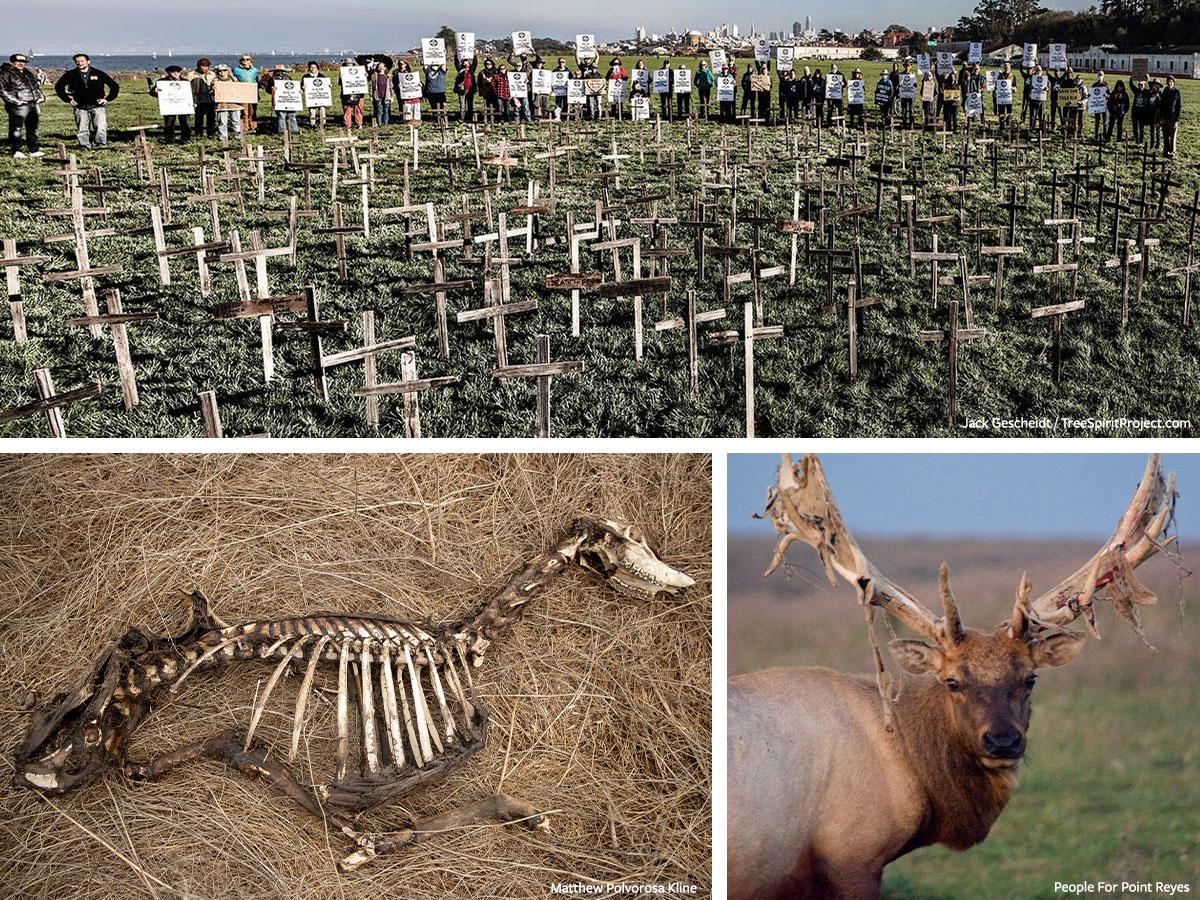Park Service Kills Half the Tule Elk Trapped in Point Reyes National Seashore Reserve
The National Park Service has just released its annual Tule elk numbers for the 2020-to-2021 season — a count of how many of the elk confined inside the fenced Tule Elk Reserve at northernmost Point Reyes National Seashore are still alive and it’s heartbreaking.
The new December 2021 Tule elk numbers are horrific: 72 more elk have died (or were not born) since last year, leaving only 221 elk remaining in the Reserve. In 2020, there were 293 elk, already down dramatically from 445 elk in 2019. This means 25% of the herd has died in just the last year — or been allowed to die by theNational Park Service’s (NPS) willful inaction intended to kill Tule elk in a way it hopes the public won’t blame it for.
All told, since 2019 over 50% of this unique, oceanside national park’s rare Tule elk, trapped in its fenced “Reserve,” have been killed by the NPS’ mismanagement policies. These policies favor the will of cattle ranchers over the welfare of wild animals whom the public assumes, incorrectly, are being prioritized and protected inside the boundaries of a national park.
The “Tule Elk Reserve’s” 3-mile-long, 8-foot-tall fence prevents the Tule elk from reaching food and water available just yards away, where thousands of cows roam, graze, and are fattened for their violent and bloody slaughter in commercial cattle operations leasing land from this public park. Cattle, enslaved for human profit, eat and drink as much as they need to — before being slaughtered for their flesh, or milked and then later slaughtered once their bodies are worn out and not as productive as their human captors desire.
The staggering Tule elk death toll vindicates In Defense of Animals’ year-plus of activism that includes rallies, demonstrations, public education, media outreach and daring, unauthorized water drops to help Tule elk, and reach the end goal — freeing them inside this national park. Along with other animal rights and environmental groups, In Defense of Animals has been pressuring the NPS to either free the elk or feed and water them until they do, in order to minimize elk deaths.
Even more Tule elk would have died in 2021, succumbing to California’s ongoing record, seasonal summer-autumn drought, if activists and citizens hadn’t been sounding the alarm at an obstinately passive NPS.
Our and other activists’ actions finally resulted in the NPS providing a few water troughs and mineral licks because it was taking a well-deserved public relations beating in the media and the public consciousness.
The NPS’ brutal, negligent, and lethal treatment of its largest ungulates is due to the political and financial pressures exerted by the beef and dairy industry operators at Point Reyes National Seashore. Cattle ranchers don’t want any Tule elk competing with cattle for forage and water. This is despite the fact that the land the cattle graze upon is owned by the public, is inside this unique Bay Area national park, and is rented at heavily discounted rates. This also explains their refusal to leave, as agreed upon when the park was created in 1962.
As a result of the NPS prioritizing the cattle operations’ bottom line over the lives of wild animals, the annual elk count could be called an “Elk Death Count.” The “Reserve” is more appropriately labeled as a “Deadly Zoo Enclosure’' because so many Tule elk die inside it, prevented from accessing the park’s full 71,000 acres.
The beef and dairy businesses not only have a fatal effect on Tule elk, but they also degrade and pollute the 28,000 acres they occupy. And of course exploit, abuse, and eventually brutally kill their own captive animals, all for profit.
In Defense of Animals, along with other animal rights and environmental groups, are more angry, focused, and determined than ever to keep working to change the atrocious and cruel Tule elk and cattle predicament at Point Reyes.
Your support helps fund our ongoing actions, rallies, demonstrations, public education, and outreach.
You can help this ongoing mission of mercy by making as generous a donation as you can.
Finally, you can also help every time you buy groceries. It is critical that we begin to make the connection between what we purchase and what that money truly pays for. When we buy the products of cattle and sheep ranchers in the forms of meat, dairy, wool, or leather, we are driving the killing of Tule elk, bison, wolves, wild horses, mountain lions, coyotes, kangaroos, and other native wild animals all over the world on their ranges, not to mention supporting the bloody deaths of the cattle and sheep themselves despite our best intentions. Please vow to transition to a cruelty-free lifestyle starting today.


